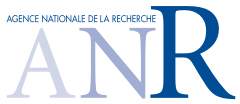

 Programme blanc N° ANR-08-BLAN-0317-01/02
Programme blanc N° ANR-08-BLAN-0317-01/02Conférence
Date et durée: 4-8 juin 2012
Thèmes: Tous les thèmes du programme ANR SÉDIGA
Organisateurs: Alexandru Dimca, Claus Hertling & Claude Sabbah
Contacts:
Inscription préalable nécessaire auprès du CIRM
Affiche de la conférence
Lundi 4 juin
9h15-10h30 Francesco Baldassarri: Irregular singularities in dimension 2, Berkovich curves, and differential operators of infinite order
Résumé: I would like to explain Kedlaya's strategy for proving the Conjecture of Sabbah on the existence of a good formal structure for a singular connection in dimension 2. I will carefully describe the Berkovich spaces that may be attached to a surface \(X\) with a marked divisor with normal crossings \(Z\), in particular the 2-dimensional non-archimedean tube of \(Z\) in \(X\) over the complex field \(\mathbb{C}\), and the smooth \(\mathbb{C}(\!(T)\!)\)-analytic curve obtained by deforming a local equation of \(Z\) in \(X\). I will describe the decomposition of the restriction to this \(\mathbb{C}(\!(T)\!)\)-curve of an integrable connection on \(X\) with a polar singularity along \(Z\), according to the radius of convergence of solutions. It seems reasonable to expect that there exist sheaves of rings of differential operators of infinite order on the formal completion of \(X\) along \(Z\), with fast formal decay along \(Z\), capable to detect the irregularity behaviour of the connection along \(Z\).
10h30-11h Pause café
11h-12h15 Takuro Mochizuki: Harmonic bundle and twistor \(\mathcal D\)-module pdf
Résumé: I will give a survey of the theory of harmonic bundles and twistor \(\mathcal D\)-modules. I would like to mention a reduction of an instanton to wild harmonic bundle, if time permits.
12h30 Déjeuner
16h30-17h45 Adriano Marmora: Product formula for \(p\)-adic epsilon factors
Résumé: Let \(X\) be proper and smooth curve on a finite field of characteristic \(p\) and \(\ell\) be a prime different from \(p\). In 1987, Laumon proved a formula, conjectured by Deligne, which correlates the constant appearing in the functional equation of the \(L\)-function of an \(\ell\)-adic sheaf over \(X\), with the product of local data (the epsilon factors) at the points of \(X\). In this talk, we report on the analogue of this formula in rigid (\(p\)-adic) cohomology, which has been recently proved in a joint work with Tomoyuki Abe.
17h45-18h Pause
18h-19h15 Yves André: Uniform sheaves and differential modules
Résumé: Real blow-ups and more refined "zooms" play a key role in
the analysis of singularities of complex-analytic differential modules.
They don't change the underlying topology, but the uniform structure.
This suggests to revisit the cohomology theory of differential
modules with help of a suitable notion of "uniform sheaves" based on
the uniformity rather than on the topology.
We shall also investigate the \(p\)-adic situation from the "uniform"
viewpoint, recalling Baker's interpretation of Berkovich spaces as
completions, and discussing the \(p\)-adic analogs of sectors.
19h30 Dîner
Mardi 5 juin
9h15-10h30 Carlos Simpson: Restriction of unipotent logarithmic connections and twistor
structures
Résumé: We will discuss some aspects of how to look at the restriction of
a logarithmic connection with nilpotent residues, to components
of the complementary normal crossings divisor. One useful point of view
is the notion of action of a Lie algebroid as it appears in Tortella's
thesis. The goal is to understand how the limiting variations of mixed
twistor structures work, in the context of an ongoing project with
Donagi and Pantev.
10h30-11h Pause café
11h-12h15 Masa-Hiko Saito: Geometry of moduli spaces of linear connections on curves and differential equations of Painlevé type
Résumé: In this talk, I will explain algebro-geometric approach of construction of moduli spaces of linear connections with fixed formal type of regular or irregular singularities on a smooth projective curve due to M. Inaba, K. Iwasaki and myself. After we establish the moduli spaces as smooth quasi-projective symplectic schemes, we will discuss about the applications to Riemann-Hilbert correspondences, Painlevé property of isomonodromic differential equations and classical Painlevé equations. If time permits, I would like to report on geometric properties of the moduli spaces such as canonical coordinates by apparent singularities (a joint work with S. Szabo) and Lagrangian fibrations (joint works with F. Loray and C. Simpson).
12h30 Déjeuner
16h30-17h45 Frank Loray: Lagrangian fibrations on moduli spaces of connections
Résumé: We investigate the geometry of moduli spaces of rank 2 logarithmic connections on curves. After recalling what is known on the Painlevé VI case (genus 0 with 4 poles), we will describe some work in progress with Masa-Hiko Saito on the Garnier case (genus 0 with \(n\) poles) and the relationship for \(n=6\) with the case of holomorphic connections on genus 2 curves (joint work with Viktoria Heu).
17h45-18h Pause
18h-19h15 Philip Boalch: Irregular connections, Dynkin diagrams and fission pdf
Résumé: I'll start by surveying the irregular nonabelian Hodge correspondence
on curves, describe many examples of the moduli spaces which arise
and in
particular the example underlying the Drinfeld-Jimbo quantum group
yielding the geometric origins of the quantum Weyl group. Then the
general construction of the corresponding irregular Betti spaces (wild
character
varieties) as algebraic symplectic manifolds will be sketched and
the irregular generalisation of the mapping class groups which act on
the Betti spaces will be described. If there's any time left over I
will describe how thinking carefully about connections on parahoric
torsors leads to a moduli theoretic realisation of the multiplicative
Brieskorn-Grothedieck-Springer resolution.
19h30 Dîner
Mercredi 6 juin
9h-10h Christian Sevenheck: Mirror symmetry and \(\mathcal D\)-modules
Résumé: The aim of this talk is to explain how mirror symmetry can be expressed using differential equations. Among the topics I am going to speak about are: Gauß-Manin systems, hypergeometric differential equations, non-commutative Hodge structures, Frobenius manifolds and primitive forms.
10h-10h15 Pause café
10h15-11h15 Hiroshi Iritani: Functoriality in Gromov-Witten theory
Résumé: Gromov-Witten theory (or quantum cohomology),
does not have an obvious functoriality under maps
between smooth projective varieties (or symplectic manifolds).
However, it has been observed in several examples that
Gromov-Witten theory of birational varieties are sometimes
related by analytic continuation in quantum parameters.
In this talk, I will talk about global analytic continuation
of quantum cohomology Frobenius manifolds and
higher genus Gromov-Witten potentials.
11h15-11h30 Pause
11h30-12h30 Todor Milanov: Integrable hierarchies for hypersurface singularities pdf
Résumé: Given a manifold \(X\) with semi-simple quantum cohomology one can associate an integrable hierarchy, which governs the Gromov--Witten invariants of \(X\). This result was proved recently by Dubrovin-Zhang and by Shadrin, who managed to construct a bi-Hamiltonian system of PDE on the loop space of H*(\(X\)). In my approach, the goal is to obtain Hirota bi-linear equations for the tau functions of the above hierarchies. It is a very subtle problem whether such equations exist at all, but nevertheless in collaboration with B. Bakalov we managed to develop a conceptual construction which works very well for simple singularities. The problem however, is to develop further the theory of generalized root system coming from vanishing cycles as well as to improve our understanding of the topology of the complement to the discriminant.
12h30 Déjeuner
19h30 Dîner
Jeudi 7 juin
9h15-10h30 Claus Hertling: Marked singularities, their moduli spaces, and atlases of Stokes data pdf
Résumé: The first part of the talk is on a global study of \(\mu\)-constant families of holomorphic function germs with isolated singularities. Some new data are defined and discussed, \(\mu\)-constant monodromy groups, marked singularities, their global moduli spaces, and a global Torelli type conjecture for their Brieskorn lattices. The second part of the talk is on universal unfoldings, Brieskorn lattices at semisimple points, their Stokes data and distinguished bases, and a global Lyashko-Looijenga map. For the simple singularities (by work of Looijenga and Deligne 73/74) and the simple elliptic singularities (joint work with C. Roucairol) this leads to an understanding of a certain global base space as an atlas of Stokes data.
10h30-11h Pause café
11h-12h15 Ian Strachan: Symmetries and duality for F-manifolds
Résumé: F-manifolds were introduced by Hertling and Manin. Building on the idea of "almost dual" Frobenius manifolds, Manin introduced the idea of an eventual identity. In this talk the construction and characterization of such eventual identities will be described, together with a duality (as opposed to almost-duality) for F-manifolds with compatible connections. In time permits, the role of F-manifolds and eventual identities in the theory of (dispersionless) integrable systems will be given. [Joint work with Liana David].
12h30 Déjeuner
16h30-17h45 Andras Némethi: Lattice cohomology
Résumé: We review the basic motivations, definitions and
properties of the
lattice cohomology associated with links of surface singularities.
We also
list its connections with analytic invariants (cohomology of line
bundles on the resolution, multivariable divisorial filtration of the
structure ring and its Poincare series), respectively Heegaard-Floer
and Seiberg-Witten theory of the link (as an oriented 3-manifold).
17h45-18h Pause
18h-19h15 Daniel Barlet: Contruction of quasi-invariant holomorphic parameters for the Gauss-Manin connection of a holomorphic map to a curve
Résumé: When we consider a holomorphic map \(\widetilde f: X \to C\) from a complex manifold \(X\) to a smooth complex curve \(C\) with a critical value at a point 0 in \(C\), the choice of a local coordinate near this point allows to dispose of an holomorphic function \(f\). Then we may construct, using this function, an \((a,b)\)-module structure on the cohomology sheaves of the formal completion (in \(f\)) of the complex of sheaves \((\mathrm{Ker}\,df^\bullet,d^\bullet)\) on \(\widetilde f{}^{-1}(0)\).
These \((a,b)\)-modules represent a filtered version of the Gauss-Manin connection of \(f\). The simplest example of this construction is the Brieskorn module of a function with an isolated singular point. But it is clear that this construction depends seriously on the choice of the function \(f\), that is to say on the choice of the local coordinate near the critical point 0 in the complex curve \(C\).
The aim of the present talk is to study the behaviour of such constructions when we make a change of local coordinate near the origin. We consider the case of frescos. A fresco is a monogenic geometric \((a,b)\)-modules corresponding to a minimal filtered differential equation associated to a single relative de Rham cohomology class on \(X\).
19h30 Dîner (Bouillabaisse)
Vendredi 8 juin
9h15-10h30 Alexandru Suciu: Green-Lazarsfeld sets and the topology of smooth algebraic varieties pdf
Résumé: The Green-Lazarsfeld sets of a smooth, quasi-projective variety \(X\) are the support loci for cohomology with coefficients in rank one local systems. These sets, which consist of translated subtori of the character group of \(\pi_1(X)\), provide valuable information on the homology of abelian covers of the given variety. Closely related, and much easier to compute, are the resonance varieties associated to the cohomology ring of \(X\). The interplay between the various types of cohomology jump loci of a smooth algebraic variety leads to a deeper understanding of the nature of its fundamental group, and its homological and geometric finiteness properties.
10h30-11h Pause café
11h-12h15 Richard Hain: Morse theory and the topology of moduli spaces of curves
Résumé: In this talk I will explain how Morse theory (classical and
stratified) can be used as a tool for understandingthe topology of
moduli spaces of curves in low genus.
12h30 Déjeuner
14h-15h15 Stefan Papadima: Classifying spaces and cohomology jump loci
Résumé: I will discuss the moduli space of curves with symplectic marking and related classifying spaces, through the prism of Green-Lazarsfeld sets and their infinitesimal analogs.
15h15-15h30 Pause
15h30-16h45 Alexandru Dimca: Hyperplane arrangements: recent results and open questions
Résumé: In this survey talk I will try to present a number of recent results concerning the monodromy action on the cohomology of the Milnor fiber of a complex central hyperplane arrangement. A number of open questions will also be discussed, in particular whether the monodromy is determined by the intersection lattice. Mixed Hodge theory plays a key role in this story.
19h30 Dîner